Financial Accounting: Acquisition Methods for Hamilton Ltd.
VerifiedAdded on 2023/01/17
|7
|1371
|50
Report
AI Summary
This report examines various acquisition methods that Hamilton Ltd could employ to gain access to Orange Ltd's patented technology. The primary recommendation is the acquisition of 80% of Orange Ltd's shares, offering Hamilton Ltd comprehensive control over its assets and liabilities. The report details several acquisition strategies, including mergers and acquisitions, asset acquisitions, and consolidation, outlining the steps involved in each method. It emphasizes the importance of identifying the acquirer, measuring the cost of the transaction, and allocating costs, along with accounting for goodwill. The report also discusses relevant accounting standards, such as AASB 5 (Non-current Assets Held for Sale and Discontinued Operations) and AASB 8 (Operating Segments), and their implications for financial reporting. The conclusion reiterates the advantages of acquiring 80% of Orange Ltd's shares for Hamilton Ltd, providing unlimited access to resources and facilitating the use of the patented technology.
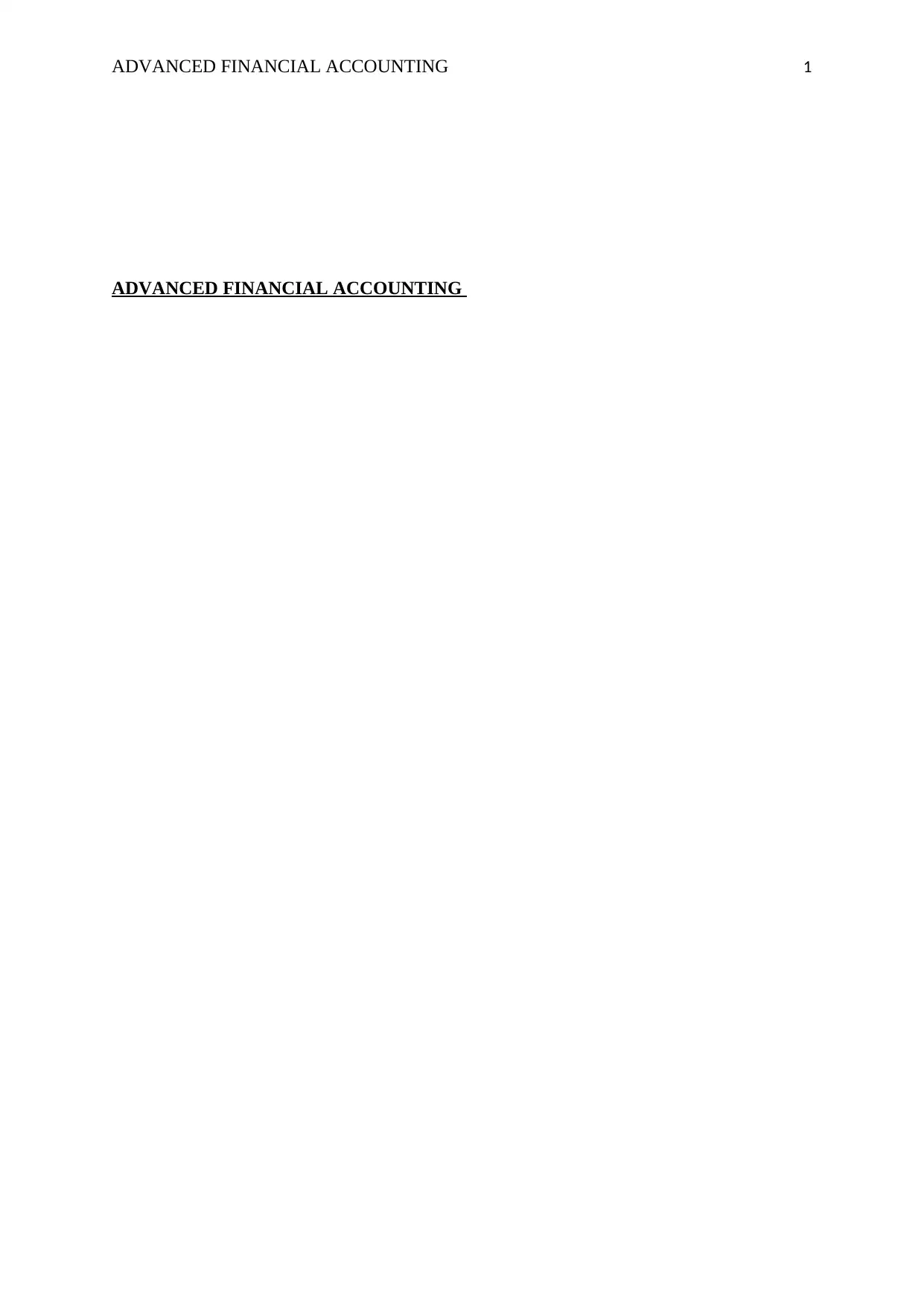
ADVANCED FINANCIAL ACCOUNTING 1
ADVANCED FINANCIAL ACCOUNTING
ADVANCED FINANCIAL ACCOUNTING
Paraphrase This Document
Need a fresh take? Get an instant paraphrase of this document with our AI Paraphraser
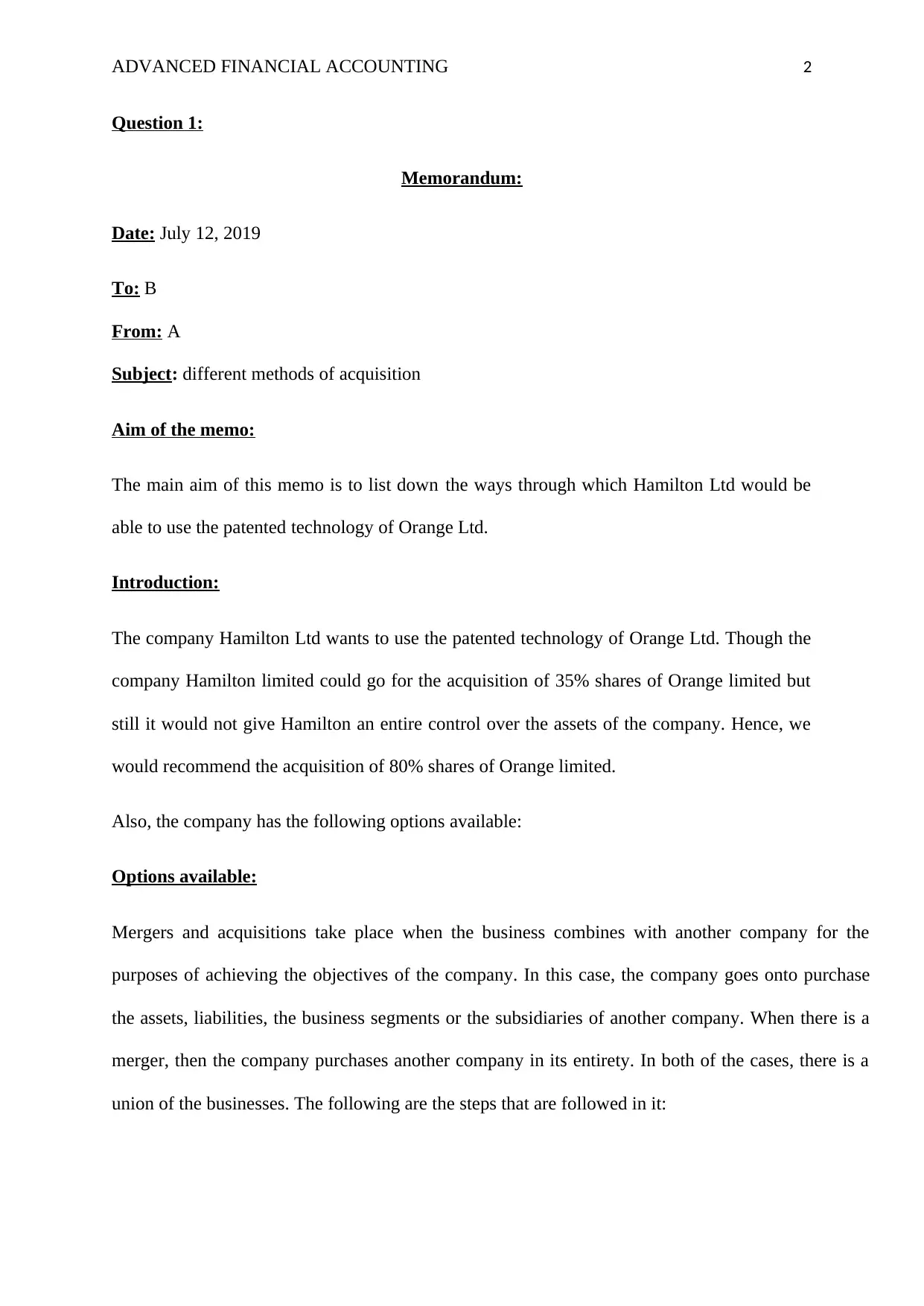
ADVANCED FINANCIAL ACCOUNTING 2
Question 1:
Memorandum:
Date: July 12, 2019
To: B
From: A
Subject: different methods of acquisition
Aim of the memo:
The main aim of this memo is to list down the ways through which Hamilton Ltd would be
able to use the patented technology of Orange Ltd.
Introduction:
The company Hamilton Ltd wants to use the patented technology of Orange Ltd. Though the
company Hamilton limited could go for the acquisition of 35% shares of Orange limited but
still it would not give Hamilton an entire control over the assets of the company. Hence, we
would recommend the acquisition of 80% shares of Orange limited.
Also, the company has the following options available:
Options available:
Mergers and acquisitions take place when the business combines with another company for the
purposes of achieving the objectives of the company. In this case, the company goes onto purchase
the assets, liabilities, the business segments or the subsidiaries of another company. When there is a
merger, then the company purchases another company in its entirety. In both of the cases, there is a
union of the businesses. The following are the steps that are followed in it:
Question 1:
Memorandum:
Date: July 12, 2019
To: B
From: A
Subject: different methods of acquisition
Aim of the memo:
The main aim of this memo is to list down the ways through which Hamilton Ltd would be
able to use the patented technology of Orange Ltd.
Introduction:
The company Hamilton Ltd wants to use the patented technology of Orange Ltd. Though the
company Hamilton limited could go for the acquisition of 35% shares of Orange limited but
still it would not give Hamilton an entire control over the assets of the company. Hence, we
would recommend the acquisition of 80% shares of Orange limited.
Also, the company has the following options available:
Options available:
Mergers and acquisitions take place when the business combines with another company for the
purposes of achieving the objectives of the company. In this case, the company goes onto purchase
the assets, liabilities, the business segments or the subsidiaries of another company. When there is a
merger, then the company purchases another company in its entirety. In both of the cases, there is a
union of the businesses. The following are the steps that are followed in it:
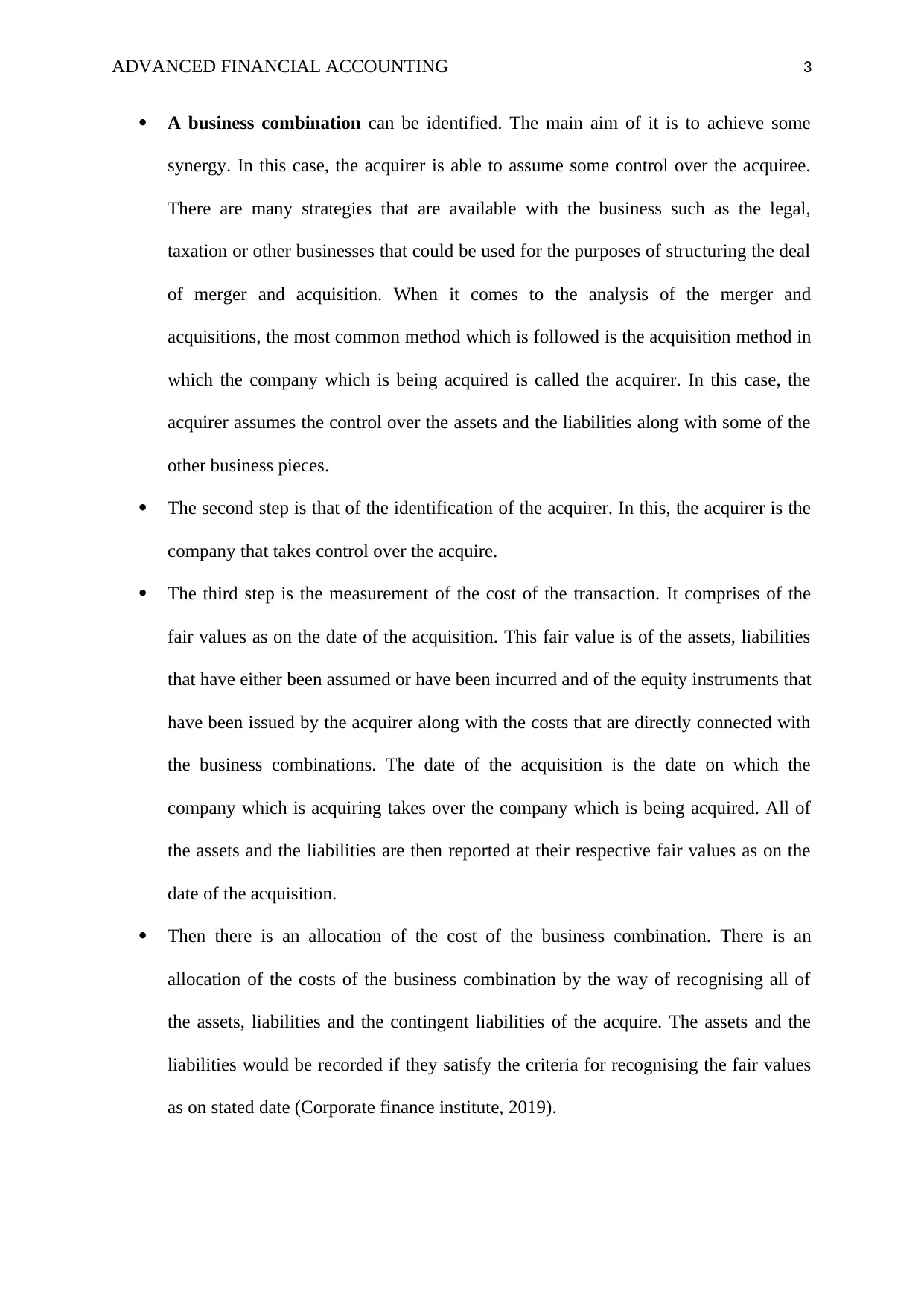
ADVANCED FINANCIAL ACCOUNTING 3
A business combination can be identified. The main aim of it is to achieve some
synergy. In this case, the acquirer is able to assume some control over the acquiree.
There are many strategies that are available with the business such as the legal,
taxation or other businesses that could be used for the purposes of structuring the deal
of merger and acquisition. When it comes to the analysis of the merger and
acquisitions, the most common method which is followed is the acquisition method in
which the company which is being acquired is called the acquirer. In this case, the
acquirer assumes the control over the assets and the liabilities along with some of the
other business pieces.
The second step is that of the identification of the acquirer. In this, the acquirer is the
company that takes control over the acquire.
The third step is the measurement of the cost of the transaction. It comprises of the
fair values as on the date of the acquisition. This fair value is of the assets, liabilities
that have either been assumed or have been incurred and of the equity instruments that
have been issued by the acquirer along with the costs that are directly connected with
the business combinations. The date of the acquisition is the date on which the
company which is acquiring takes over the company which is being acquired. All of
the assets and the liabilities are then reported at their respective fair values as on the
date of the acquisition.
Then there is an allocation of the cost of the business combination. There is an
allocation of the costs of the business combination by the way of recognising all of
the assets, liabilities and the contingent liabilities of the acquire. The assets and the
liabilities would be recorded if they satisfy the criteria for recognising the fair values
as on stated date (Corporate finance institute, 2019).
A business combination can be identified. The main aim of it is to achieve some
synergy. In this case, the acquirer is able to assume some control over the acquiree.
There are many strategies that are available with the business such as the legal,
taxation or other businesses that could be used for the purposes of structuring the deal
of merger and acquisition. When it comes to the analysis of the merger and
acquisitions, the most common method which is followed is the acquisition method in
which the company which is being acquired is called the acquirer. In this case, the
acquirer assumes the control over the assets and the liabilities along with some of the
other business pieces.
The second step is that of the identification of the acquirer. In this, the acquirer is the
company that takes control over the acquire.
The third step is the measurement of the cost of the transaction. It comprises of the
fair values as on the date of the acquisition. This fair value is of the assets, liabilities
that have either been assumed or have been incurred and of the equity instruments that
have been issued by the acquirer along with the costs that are directly connected with
the business combinations. The date of the acquisition is the date on which the
company which is acquiring takes over the company which is being acquired. All of
the assets and the liabilities are then reported at their respective fair values as on the
date of the acquisition.
Then there is an allocation of the cost of the business combination. There is an
allocation of the costs of the business combination by the way of recognising all of
the assets, liabilities and the contingent liabilities of the acquire. The assets and the
liabilities would be recorded if they satisfy the criteria for recognising the fair values
as on stated date (Corporate finance institute, 2019).
⊘ This is a preview!⊘
Do you want full access?
Subscribe today to unlock all pages.

Trusted by 1+ million students worldwide
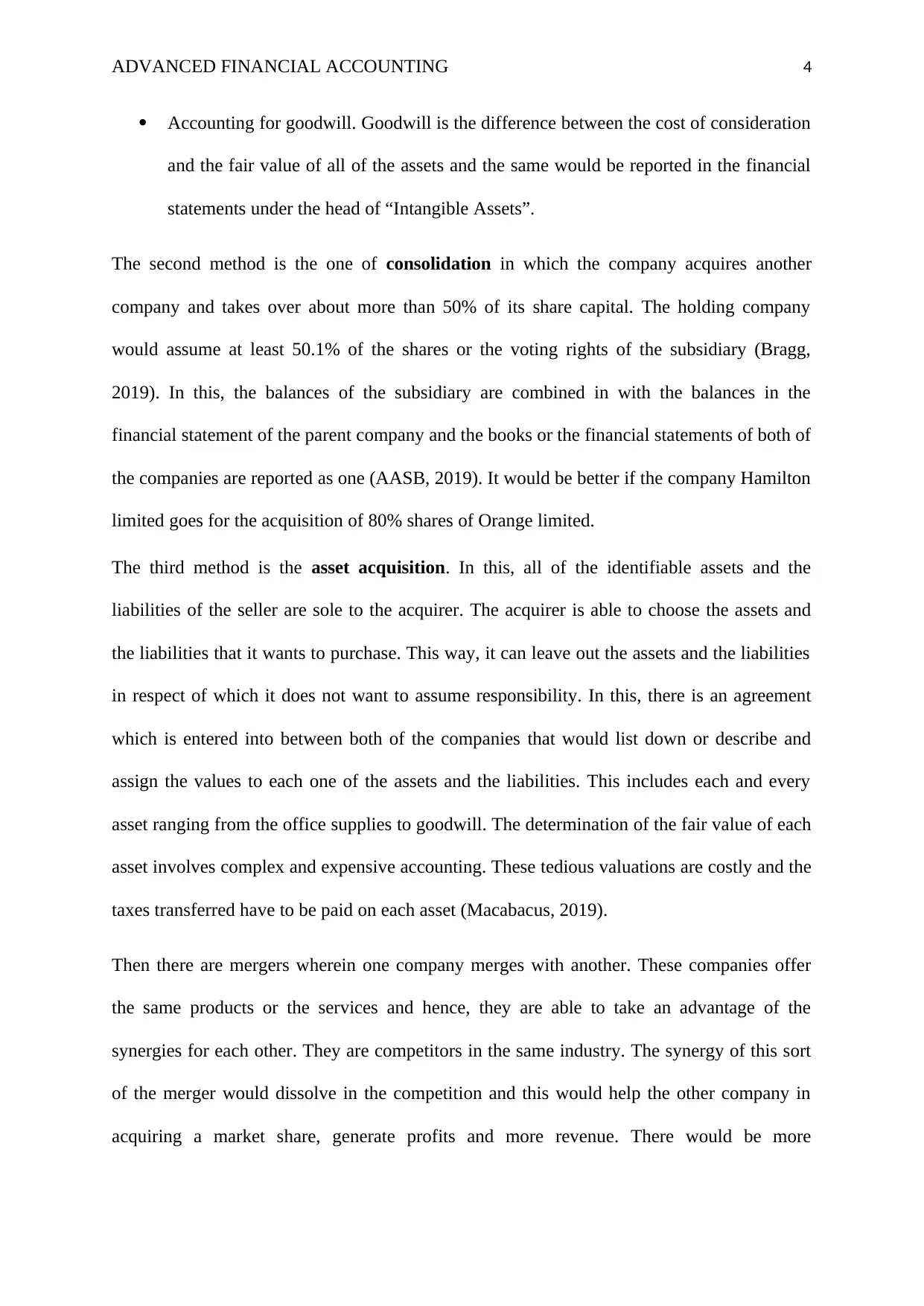
ADVANCED FINANCIAL ACCOUNTING 4
Accounting for goodwill. Goodwill is the difference between the cost of consideration
and the fair value of all of the assets and the same would be reported in the financial
statements under the head of “Intangible Assets”.
The second method is the one of consolidation in which the company acquires another
company and takes over about more than 50% of its share capital. The holding company
would assume at least 50.1% of the shares or the voting rights of the subsidiary (Bragg,
2019). In this, the balances of the subsidiary are combined in with the balances in the
financial statement of the parent company and the books or the financial statements of both of
the companies are reported as one (AASB, 2019). It would be better if the company Hamilton
limited goes for the acquisition of 80% shares of Orange limited.
The third method is the asset acquisition. In this, all of the identifiable assets and the
liabilities of the seller are sole to the acquirer. The acquirer is able to choose the assets and
the liabilities that it wants to purchase. This way, it can leave out the assets and the liabilities
in respect of which it does not want to assume responsibility. In this, there is an agreement
which is entered into between both of the companies that would list down or describe and
assign the values to each one of the assets and the liabilities. This includes each and every
asset ranging from the office supplies to goodwill. The determination of the fair value of each
asset involves complex and expensive accounting. These tedious valuations are costly and the
taxes transferred have to be paid on each asset (Macabacus, 2019).
Then there are mergers wherein one company merges with another. These companies offer
the same products or the services and hence, they are able to take an advantage of the
synergies for each other. They are competitors in the same industry. The synergy of this sort
of the merger would dissolve in the competition and this would help the other company in
acquiring a market share, generate profits and more revenue. There would be more
Accounting for goodwill. Goodwill is the difference between the cost of consideration
and the fair value of all of the assets and the same would be reported in the financial
statements under the head of “Intangible Assets”.
The second method is the one of consolidation in which the company acquires another
company and takes over about more than 50% of its share capital. The holding company
would assume at least 50.1% of the shares or the voting rights of the subsidiary (Bragg,
2019). In this, the balances of the subsidiary are combined in with the balances in the
financial statement of the parent company and the books or the financial statements of both of
the companies are reported as one (AASB, 2019). It would be better if the company Hamilton
limited goes for the acquisition of 80% shares of Orange limited.
The third method is the asset acquisition. In this, all of the identifiable assets and the
liabilities of the seller are sole to the acquirer. The acquirer is able to choose the assets and
the liabilities that it wants to purchase. This way, it can leave out the assets and the liabilities
in respect of which it does not want to assume responsibility. In this, there is an agreement
which is entered into between both of the companies that would list down or describe and
assign the values to each one of the assets and the liabilities. This includes each and every
asset ranging from the office supplies to goodwill. The determination of the fair value of each
asset involves complex and expensive accounting. These tedious valuations are costly and the
taxes transferred have to be paid on each asset (Macabacus, 2019).
Then there are mergers wherein one company merges with another. These companies offer
the same products or the services and hence, they are able to take an advantage of the
synergies for each other. They are competitors in the same industry. The synergy of this sort
of the merger would dissolve in the competition and this would help the other company in
acquiring a market share, generate profits and more revenue. There would be more
Paraphrase This Document
Need a fresh take? Get an instant paraphrase of this document with our AI Paraphraser
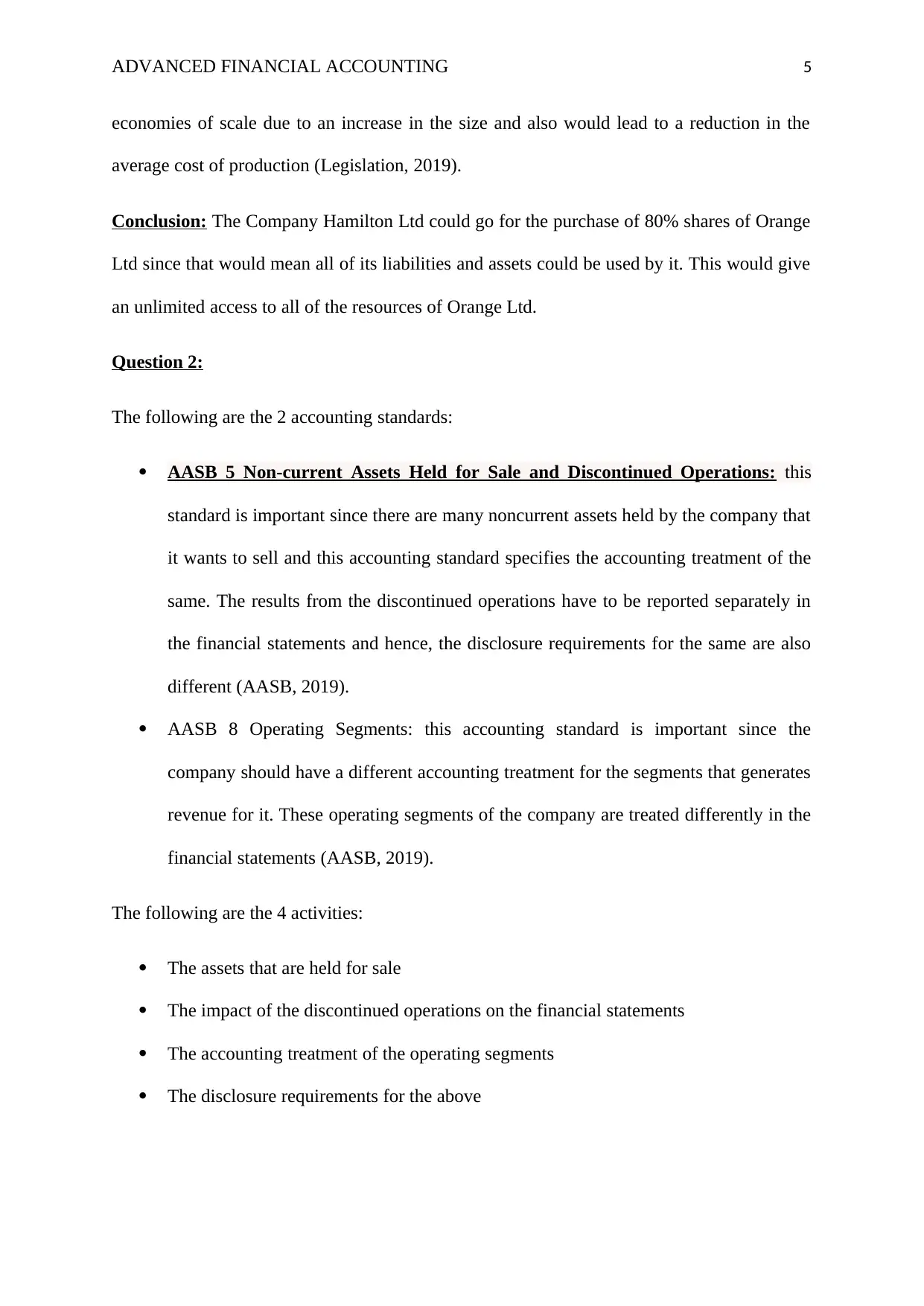
ADVANCED FINANCIAL ACCOUNTING 5
economies of scale due to an increase in the size and also would lead to a reduction in the
average cost of production (Legislation, 2019).
Conclusion: The Company Hamilton Ltd could go for the purchase of 80% shares of Orange
Ltd since that would mean all of its liabilities and assets could be used by it. This would give
an unlimited access to all of the resources of Orange Ltd.
Question 2:
The following are the 2 accounting standards:
AASB 5 Non-current Assets Held for Sale and Discontinued Operations: this
standard is important since there are many noncurrent assets held by the company that
it wants to sell and this accounting standard specifies the accounting treatment of the
same. The results from the discontinued operations have to be reported separately in
the financial statements and hence, the disclosure requirements for the same are also
different (AASB, 2019).
AASB 8 Operating Segments: this accounting standard is important since the
company should have a different accounting treatment for the segments that generates
revenue for it. These operating segments of the company are treated differently in the
financial statements (AASB, 2019).
The following are the 4 activities:
The assets that are held for sale
The impact of the discontinued operations on the financial statements
The accounting treatment of the operating segments
The disclosure requirements for the above
economies of scale due to an increase in the size and also would lead to a reduction in the
average cost of production (Legislation, 2019).
Conclusion: The Company Hamilton Ltd could go for the purchase of 80% shares of Orange
Ltd since that would mean all of its liabilities and assets could be used by it. This would give
an unlimited access to all of the resources of Orange Ltd.
Question 2:
The following are the 2 accounting standards:
AASB 5 Non-current Assets Held for Sale and Discontinued Operations: this
standard is important since there are many noncurrent assets held by the company that
it wants to sell and this accounting standard specifies the accounting treatment of the
same. The results from the discontinued operations have to be reported separately in
the financial statements and hence, the disclosure requirements for the same are also
different (AASB, 2019).
AASB 8 Operating Segments: this accounting standard is important since the
company should have a different accounting treatment for the segments that generates
revenue for it. These operating segments of the company are treated differently in the
financial statements (AASB, 2019).
The following are the 4 activities:
The assets that are held for sale
The impact of the discontinued operations on the financial statements
The accounting treatment of the operating segments
The disclosure requirements for the above
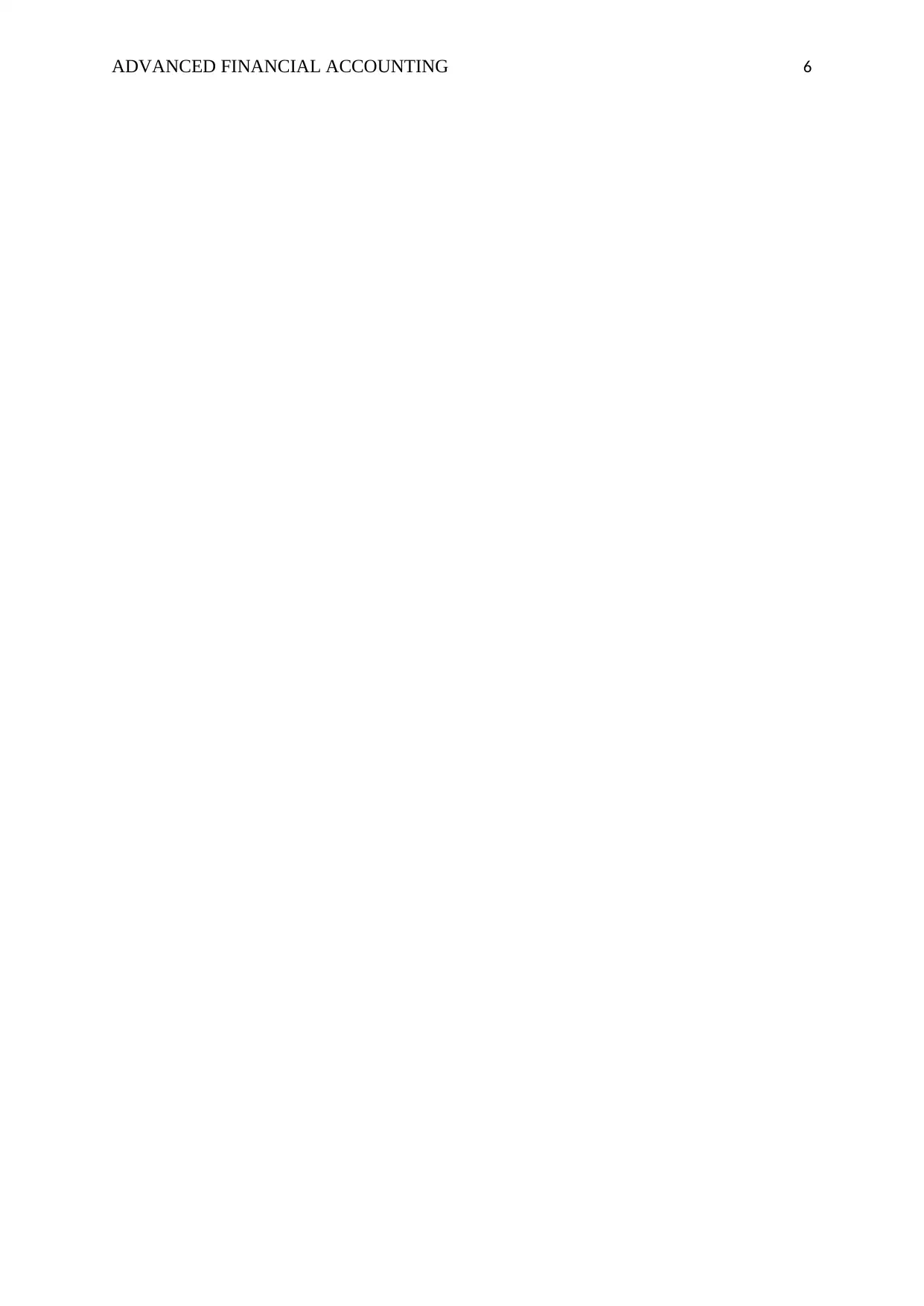
ADVANCED FINANCIAL ACCOUNTING 6
⊘ This is a preview!⊘
Do you want full access?
Subscribe today to unlock all pages.

Trusted by 1+ million students worldwide
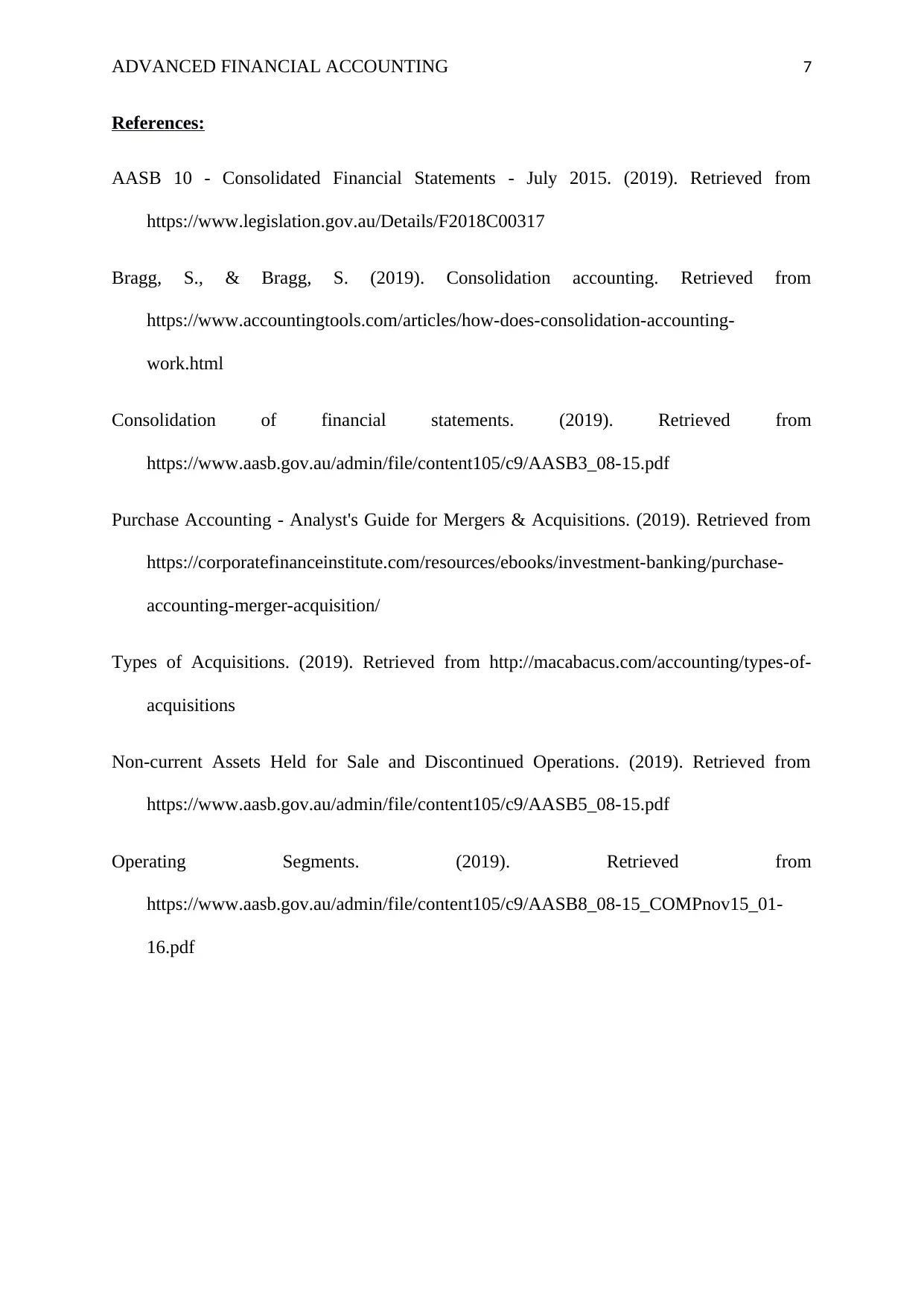
ADVANCED FINANCIAL ACCOUNTING 7
References:
AASB 10 - Consolidated Financial Statements - July 2015. (2019). Retrieved from
https://www.legislation.gov.au/Details/F2018C00317
Bragg, S., & Bragg, S. (2019). Consolidation accounting. Retrieved from
https://www.accountingtools.com/articles/how-does-consolidation-accounting-
work.html
Consolidation of financial statements. (2019). Retrieved from
https://www.aasb.gov.au/admin/file/content105/c9/AASB3_08-15.pdf
Purchase Accounting - Analyst's Guide for Mergers & Acquisitions. (2019). Retrieved from
https://corporatefinanceinstitute.com/resources/ebooks/investment-banking/purchase-
accounting-merger-acquisition/
Types of Acquisitions. (2019). Retrieved from http://macabacus.com/accounting/types-of-
acquisitions
Non-current Assets Held for Sale and Discontinued Operations. (2019). Retrieved from
https://www.aasb.gov.au/admin/file/content105/c9/AASB5_08-15.pdf
Operating Segments. (2019). Retrieved from
https://www.aasb.gov.au/admin/file/content105/c9/AASB8_08-15_COMPnov15_01-
16.pdf
References:
AASB 10 - Consolidated Financial Statements - July 2015. (2019). Retrieved from
https://www.legislation.gov.au/Details/F2018C00317
Bragg, S., & Bragg, S. (2019). Consolidation accounting. Retrieved from
https://www.accountingtools.com/articles/how-does-consolidation-accounting-
work.html
Consolidation of financial statements. (2019). Retrieved from
https://www.aasb.gov.au/admin/file/content105/c9/AASB3_08-15.pdf
Purchase Accounting - Analyst's Guide for Mergers & Acquisitions. (2019). Retrieved from
https://corporatefinanceinstitute.com/resources/ebooks/investment-banking/purchase-
accounting-merger-acquisition/
Types of Acquisitions. (2019). Retrieved from http://macabacus.com/accounting/types-of-
acquisitions
Non-current Assets Held for Sale and Discontinued Operations. (2019). Retrieved from
https://www.aasb.gov.au/admin/file/content105/c9/AASB5_08-15.pdf
Operating Segments. (2019). Retrieved from
https://www.aasb.gov.au/admin/file/content105/c9/AASB8_08-15_COMPnov15_01-
16.pdf
1 out of 7
Related Documents
Your All-in-One AI-Powered Toolkit for Academic Success.
+13062052269
info@desklib.com
Available 24*7 on WhatsApp / Email
![[object Object]](/_next/static/media/star-bottom.7253800d.svg)
Unlock your academic potential
Copyright © 2020–2025 A2Z Services. All Rights Reserved. Developed and managed by ZUCOL.





